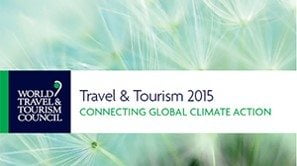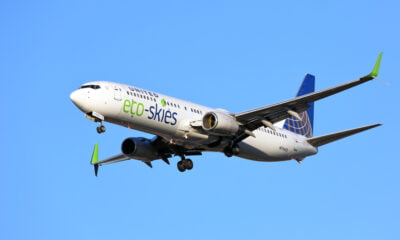

Environment
Travel & Tourism companies 20% cleaner than 2005, commit to 50% CO2 cuts by 2035
Many of the world’s biggest Travel & Tourism companies have improved their carbon efficiency by 20% in the last ten years and are on course to cut CO2 emissions by 50% by 2035, according to a major new report released today.
“Travel & Tourism 2015; Connecting Global Climate Action”, published by the World Travel & Tourism Council (WTTC), outlines the preparedness of the sector for climate change alleviation measures and demonstrates the progress that has been made by the world’s leading airlines, airports, hotels, cruise lines, car rental companies and technology companies in the last decade.
The report concludes that the world’s biggest Travel & Tourism companies, as represented by the Members of WTTC, are:
– 20% more carbon efficient today than they were in 2005
– On course to cut CO2 emissions by 50% from 2005 to 2035
– On course to reach the target of 25% reduction by 2020
In 2009, The World Travel & Tourism Council (WTTC) published “Leading the Challenge on Climate Change”, which identified key themes and action areas required to meet the target of reducing our 2035 carbon emissions by 50% based on 2005 levels. In the run up to the COP21 climate change talks in Paris at the end of this year, WTTC has reviewed progress against these themes to determine how the sector can build on this progress to respond effectively to the challenges of the future.
The initiatives and progress made to date have reduced carbon emissions to the point where WTTC Member companies are 20% less carbon-intense now than they were in 2005, closely approaching the interim target of 25% intensity reduction in 2020 set in 2009. The progress in reducing carbon intensity can be attributed to several actions across each of the themes identified in 2009:
1) Accountability and Responsibility. The sector has made strong progress against this theme, particularly in admitting to the challenge of tackling climate change and setting out plans to address and measure it. Various methodologies for calculating and measuring carbon usage have been developed and more and more companies are engaging with global frameworks for Environmental, Social and Governance (ESG) reporting such as GRI and CDP.
2) Local community sustainable growth and capacity building. WTTC members actively demonstrate on-the-ground action in the form of community engagement, charitable contributions, disaster relief, or conservation efforts. Several WTTC Member programmes address deforestation in particular, while others focus on wider biodiversity protection such as preserving coral reefs, hosting bee colonies on rooftops, managing waste, or ensuring sustainable sourcing.
3) Educating customers and stakeholders. Most Travel & Tourism companies now have branded sustainability programs, and these often include customer engagement programs
4) Greening supply chains. Most WTTC members now have formidable supplier screening and supply chain engagement programs and have developed practical tools to help procurement from local small and medium-sized enterprises (SMEs) as part of this.
5) Innovation, capital investment and infrastructure. Similar to ESG reporting being the primary step towards accountability and responsibility now, so were the use of operational environmental management systems and green certification schemes our focus in 2009. Most WTTC Member companies have achieved green certification of some type.
The report also outlines the five priority areas to support the overall target of halving emissions by 2035:
1) Integrating Climate Change and related issues into Business Strategy by disclosing climate change issues in mainstream financial reporting, utilising recognised frameworks and collaborating to harmonise the approach for disclosure within our industries. Commitments will stem from securing leadership from board governance and senior executives.
2) Supporting the Global Transition to a Low Carbon Economy by joining in the leading practice of establishing an internal price of carbon, focusing on renewables for new investments, seeking low carbon financing mechanisms, contributing to local economies with carbon mitigation, and catalysing the economies of scale to create a virtuous circle.
3) Strengthening Local Resilience by recognising the value that local natural and cultural heritage has for Travel & Tourism, enhancing the assessment of our operations and forging partnerships to build resilience against climate risks, reducing local drivers of climate change.
4) Promoting the Value of Responsible Travel by giving travellers the tools to be responsible travellers, encouraging participation in our initiatives, and offering new experiences tied directly to low carbon solutions. We will extend these tools to our business travellers who play an integral role in increasing ESG information from Travel & Tourism companies.
5) Engaging Across the Value Chain by focussing efforts on the biggest opportunities found across the entire value chain to reduce carbon emissions through mechanisms such as supplier screening and local procurement. Furthermore, Travel & Tourism is in a unique position to build consumer awareness of the world’s key supply chain threats by engaging travellers to link the destinations they visit with the issues back home in their own purchasing decisions as consumers and professionals.
David Scowsill, President & CEO, WTTC, said: “In 2015, Travel & Tourism is forecast to contribute almost 10% of world GDP and 1 in 11 of all jobs on the planet. The strength of the sector is due to continue for the next decade at almost 4% per annum. With such robust growth, Travel & Tourism’s relationship to climate change becomes critical.
“Much has changed in the six years since we published “Leading the Challenge on Climate Change” to support the global climate talks backing international agreements. While the sector has grown, added more jobs and contributed billions of dollars to economies all over the world, we have seen real commitment to sustainability from business as companies innovate and collaborate with others to reduce their overall impacts. WTTC Members are investing heavily in energy efficiency and renewable energy sources, are protecting valuable ecosystems and have been building awareness of their actions among stakeholders and customers. The majority of WTTC Members are publicly disclosing their efforts through various means of Environmental, Social and Governance (ESG) reporting.
“Per passenger, per room, per rental, per transaction, and per unit of revenue, we now serve global travellers 20% more efficiently than in 2005 and are contributing to our goal of a 50% reduction in carbon emissions by 2035.
“The next 20 years will be characterised by our sector fully integrating climate change and related issues into business strategy, supporting the global transition to a low carbon economy, strengthening resilience at a local level against climate risks, promoting the value of responsible travel, and greening entire supply chains.
“To reach these long term goals, much still needs to be done across Travel & Tourism and other sectors, but we now have a common understanding and are ever-closer to agreement on the global actions necessary.”


 Environment10 months ago
Environment10 months agoAre Polymer Banknotes: an Eco-Friendly Trend or a Groundswell?

 Environment11 months ago
Environment11 months agoEco-Friendly Home Improvements: Top 7 Upgrades for 2025

 Features9 months ago
Features9 months agoEco-Friendly Cryptocurrencies: Sustainable Investment Choices

 Features10 months ago
Features10 months agoEco-Friendly Crypto Traders Must Find the Right Exchange






























